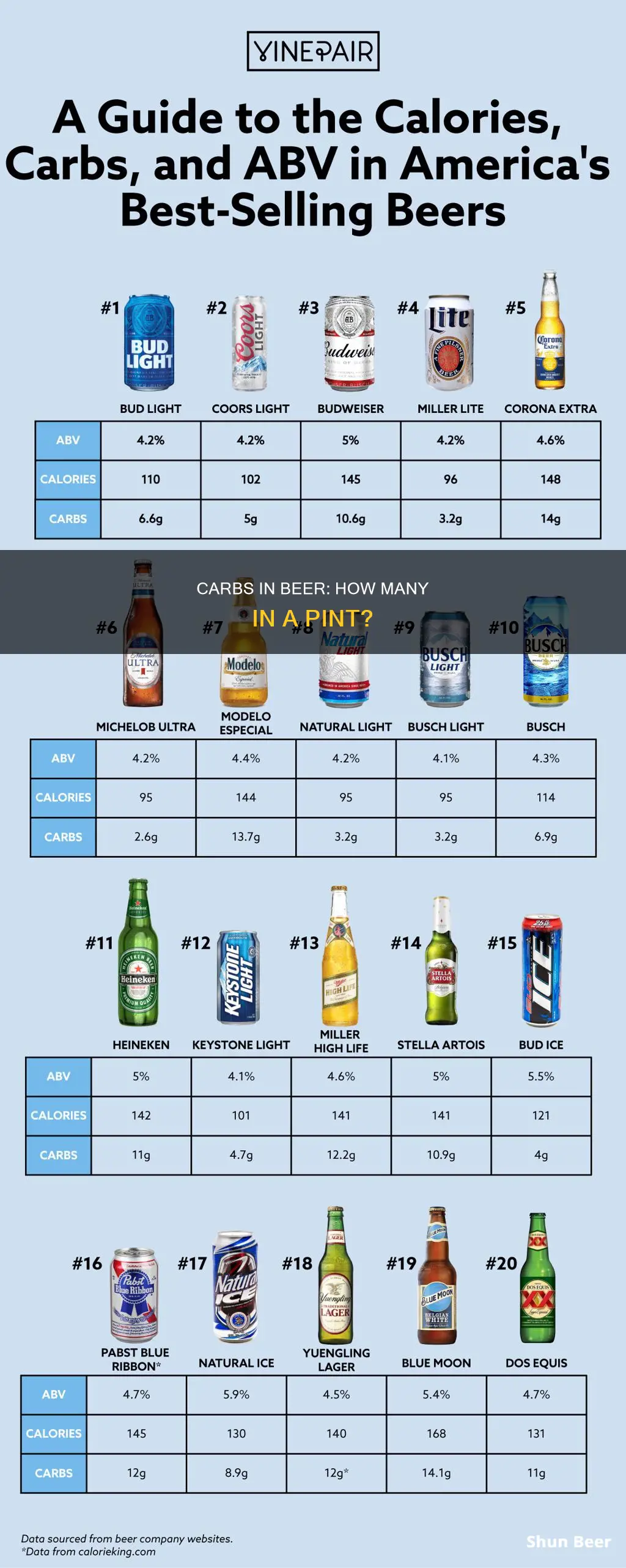
Beer is made by fermenting grains such as barley and wheat, which contain carbohydrates. The number of carbohydrates in a beer depends on the type of beer, the fermentation process, and the ingredients used. A 16 oz pint of beer typically contains between 8 and 18 grams of carbohydrates, depending on the specific beer and its ingredients. Some beers may have slightly more or less, and certain types of beer, such as lagers, tend to have fewer carbohydrates than ales or stouts.
What You'll Learn
- Beer is made from grains like barley and wheat, which contain carbohydrates
- Beer is typically high in carbohydrates, sugars, and empty calories
- A 12-ounce beer that is 4% ABV has about 150 calories, 13 grams of carbs, and 14 grams of alcohol
- Beer with higher alcohol content will have more calories than beer with lower alcohol content
- Light beers have fewer carbohydrates and more water, resulting in fewer overall calories

Beer is made from grains like barley and wheat, which contain carbohydrates
Beer is made by fermenting grains such as barley and wheat, which contain carbohydrates. The grain is harvested and processed through heating, drying, and cracking to isolate the enzymes used in beer. The malt, which determines the colour of the beer, is then added to the mash tun and left to steep in hot water, producing a sugary liquid called wort.
The beer-making process is long and labour-intensive, and a lot of science goes into it. The temperature at which the beer is brewed, for example, changes its taste, and even the water used has an impact. The type of hops used also affects the bitterness and aroma of the beer.
After boiling and adding hops, the wort is cooled and transferred to a fermentation vessel, where yeast is added. The yeast eats the sugar, creating carbon dioxide and alcohol. The length of the fermentation process depends on the variety of beer being produced. For most ales, the beer is stored for a short time at cooler temperatures, while lager is stored for longer at colder temperatures.
Finally, after the fermentation process is complete, the beer is filtered, processed, and bottled.
The number of carbohydrates in a 16-ounce pint of beer can vary depending on the type of beer and the ingredients used. However, according to one source, a 12-ounce serving of Budweiser, one of America's best-selling beers, contains 10.6 grams of carbohydrates.
Ginger Ale vs Ginger Beer: What's the Difference?
You may want to see also

Beer is typically high in carbohydrates, sugars, and empty calories
A 16-oz pint of beer usually contains around 10-15 grams of carbohydrates. This amount can vary depending on the specific beer and its ingredients. For example, a pint of Bud Light contains 6.6 grams of carbohydrates, while a pint of Budweiser contains 10.6 grams.
Beer also contains sugars, which are a type of carbohydrate. The sugar content in beer is generally low, with most regular beers being sugar-free. However, light beers tend to have slightly higher sugar content, with around 1 gram of sugar per pint. Non-alcoholic beers have the highest sugar content, as the sugar produced during the brewing process is not converted into alcohol.
In addition to carbohydrates and sugars, beer also contributes a significant number of calories. A pint of 4% ABV beer contains approximately 182 calories. The calorie content can vary depending on the alcohol content and the specific beer.
While beer can be a source of carbohydrates, sugars, and calories, it is important to note that it is also a source of other nutrients. Beer is typically made from grains, such as barley and wheat, which can provide some vitamins and minerals. Additionally, the fermentation process can produce small amounts of B vitamins and antioxidants.
Overall, beer is a beverage that is high in carbohydrates, sugars, and calories. However, it is important to consume it in moderation and as part of a balanced diet that includes a variety of other nutrients.
Beer, Ale, Lager, Stout: What Sets Them Apart?
You may want to see also

A 12-ounce beer that is 4% ABV has about 150 calories, 13 grams of carbs, and 14 grams of alcohol
Beer is made from fermenting and distilling grains with yeast, and sometimes adding fruit or spices for flavour. This means that most of the calories in beer come from alcohol and carbohydrates. In fact, about 60% of calories in beer come from alcohol, and 40% from carbohydrates.
The amount of calories in beer depends on its alcohol content. A beer with a higher alcohol content will have more calories than a beer with a lower alcohol content. This is why light beers usually have fewer calories than other options.
The number of carbohydrates in beer depends on the ingredients used and the fermentation process. Brewers make beer by fermenting grains such as barley and wheat, which contain carbohydrates. Most beers also contain added sugars, which increase the carbohydrate level.
The amount of carbohydrates in a beer can vary, but a 16-ounce pint of beer typically has about 10-15 grams of carbs. A 12-ounce beer with 4% ABV has 13 grams of carbs, while a 12-ounce Budweiser has 10.6 grams of carbs and a Bud Light has 6.6 grams.
It's important to note that the colour of a beer does not indicate its calorie or carbohydrate content. Dark-coloured beers are not necessarily high-calorie beers. The colour of the beer depends on the amount of grain used in the brewing process.
The Many Shades of Blue Moon Beers
You may want to see also

Beer with higher alcohol content will have more calories than beer with lower alcohol content
Beer is made by fermenting grains such as barley and wheat, which naturally contain carbohydrates. The number of carbohydrates in a beer varies according to the fermentation process and the amount of grains and added sugars that remain in the beer.
A standard 12-ounce serving of one of the top 10 most popular beers in the United States contains between 95 and 150 calories. Budweiser, for example, has 145 calories, while Bud Light has 110.
On average, a pint of 5% ABV beer contains around 240 calories. Lighter-coloured beers tend to contain fewer calories than darker beers because they have a lower alcohol content and lower ingredient density.
If you're looking for a low-calorie beer, BrewDog's Dead Pony Club (3.8% ABV) has 32 calories and is their lowest-calorie alcoholic beer.
Doppelbock vs. Bock Beer: Historical Differences Explained
You may want to see also

Light beers have fewer carbohydrates and more water, resulting in fewer overall calories
The number of carbohydrates in a 16-ounce pint of beer varies depending on the brand and type of beer. For example, a 12-ounce serving of Budweiser contains 10.6 grams of carbohydrates, while a 12-ounce Bud Light contains 6.6 grams. In general, light beers tend to have fewer carbohydrates and more water, resulting in fewer overall calories.
Light beers typically have a lower alcohol content, which contributes to their lower calorie count. Alcohol contains 7 calories per gram, while carbohydrates contain 4 calories per gram. By reducing the alcohol content and using exogenous brewing enzymes to break down carbohydrates, light beers can achieve a lower calorie count.
There are several methods for producing light beer. One method involves diluting regular-strength beer with water to achieve the desired alcohol and calorie content. Another method is to decrease the serving size so that the package contains fewer calories. A third method is to extend the mashing process, allowing natural enzymes in barley to break down more of the carbohydrates into simple sugars. These sugars are then fermented into alcohol and carbon dioxide, and the final product is diluted with water to create a light beer.
Light beers are popular among those looking to reduce their calorie intake without giving up beer completely. They are also often favoured for their ""non-beer" taste, with less bitterness and a lighter flavour. However, it is important to note that the difference in calories between light beer and regular beer is usually small, sometimes less than 20 calories per serving.
While light beers have fewer carbohydrates and calories, it is still important to consume them in moderation. The American Heart Association recommends that men consume no more than two alcoholic drinks per day, and women no more than one. Additionally, those on low-carb diets may need to limit their beer intake, as even light beers may not fit within their carbohydrate restrictions.
Hazy IPAs: Unfiltered Bliss or Just a Fad?
You may want to see also
Frequently asked questions
The amount of carbohydrates in beer varies depending on the type of beer and its ingredients. However, on average, there are about 10–15 grams of carbohydrates in a pint of beer.
The amount of carbohydrates in a beer depends on the ingredients used and the brewing process. Beers with a thicker mouthfeel, darker appearance, and sweeter flavor typically have more carbs.
Yes, some beers have lower carbohydrate content than others. For example, Budweiser Select 55 has 1.9 grams of carbs per serving, Miller Genuine Draft 64 has 2.4 grams, and Michelob Ultra has 2.6 grams.
Beer typically has more carbohydrates than spirits like vodka, rum, and tequila, which have zero carbs. Wine also tends to have fewer carbs, with a range of 1.2 to 3.4 grams per serving for dry wines.
Yes, one strategy is to choose “light” beers, which typically have fewer carbohydrates and more water. Additionally, low-calorie beers usually have a lower ABV, so opting for beers with a lower alcohol percentage can also reduce carbohydrate intake.







